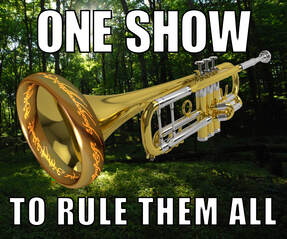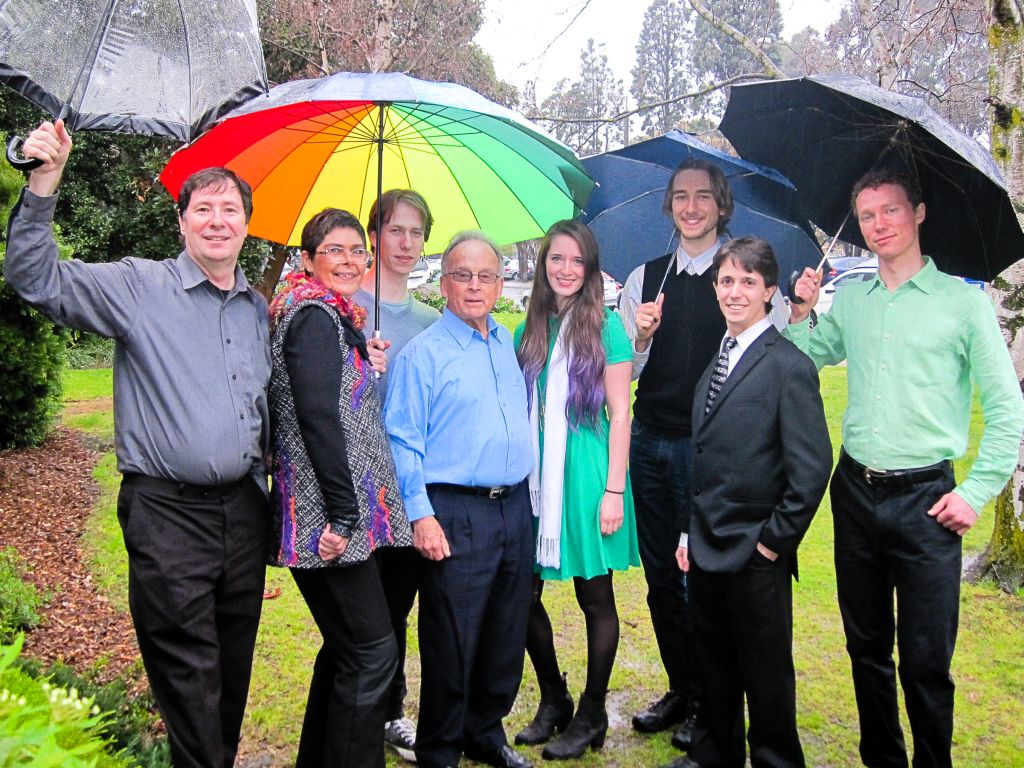ONE SHOW TO RULE THEM ALL
I assembled this show for the Melbourne Fringe Festival in 2015. I had long wanted to arrange Donald Swann's song setting "The Road Goes Ever On" for piano and baritone voice, which he wrote and recorded in 1968, for brass quintet and two voices. It forms the basis for this 70-minute performance of songs and poems from J.R.R.Tolkien's "The Lord Of The Rings" trilogy about the inhabitants of Middle-Earth and their epic struggle to free their land from the evil Lord Sauron and the Ring Of Power.
For the show, I found six scenes that included the six Swann songs (although one of these has been split into two parts) and nine other songs and dramatic statements that seemed to invite musical accompaniment. I decided to begin the show with a fanfare and chose Stravinsky's “Fanfare For A New Theatre” for two trumpets, as he was one of the composers who transformed the world of music at the beginning of the 20th century, and this seemed to be a good way to usher in the other-world of Middle-earth.
The first scene covers Bilbo's departure from the Shire to go to Rivendell where he would write his memoirs, leaving the Ring in Frodo's care. Frodo's subsequent flight from the Shire with the Ring, accompanied by Sam Gamgee, Pippin Took and Merry Brandybuck and pursued by Black Riders, is mentioned, during which they meet a band of Elves, to Sam's great delight. After this, a little time is spent with Tom Bombadil and the lady Goldberry at Tom's house in the Forest of Mirkwood.
The second scene covers the hobbits' stay in Rivendell, the holding of the Great Council, and the formation of the Company who would assist Frodo in his dreadful task of taking the Ring to Mordor and consigning it to the fires of Mount Doom in which it was originally forged by Sauron, the Dark Lord. Before they leave, they say goodbye to Bilbo.
The next scene tells of the departure of the Company in three small boats on the River Silverlode, and the song and farewell sung by Galadriel.
Then we come to the Forest of Fangorn where Treebeard, The Ent, finds Merry and Pippin and tells them something of his world.
Scene five finds Gandalf, Aragorn, Gimli and Legolas in the land of the Rohirrim, the Horse-lords, and tells of their meeting with King Théoden and his sinister adviser, Gríma Wormtongue. Having seen Gríma dismissed by Gandalf, the king seizes his power again and leads his riders to battle with the forces of Mordor, in which he is killed. At the beginning of the scene, Aragorn chants a lament to the Riders of the Mark who perished in the first great war against Sauron, and it closes with the horsemen singing a lament for Théoden Thengel's son.
The last scene includes Sam's rescue of Frodo from the Orcs in the tower of Cirith Ungol, and then their time of recovery in Ithilien after their destruction of the Ring, with Gollum's help, in the Cracks of Doom. Legolas sings of the streams that flow to the sea, which all the Elves must eventually cross when they leave Middle-earth. At the end, the hobbit-heroes farewell Bilbo in Rivendell before they return to their homes in the Shire.
While I wrote music to five of the songs and adapted music for another, Mati Gwizdalla undertook the enormous task of editing and improving my transcriptions of the Swann songs and also composed original music to two more. Nikola Shaw composed a dramatic setting of another of the songs. I thank them both very much, because their contribution has been essential to the realisation of my idea.
They also play trumpet (and flugelhorn) and bass trombone, respectively, in the quintet, along with Anthony Foon (trumpet and flugelhorn), Bruce Ikin (French horn) and Luc Weiner (trombone). Together with singers Robert Dora and Sam Frazer I offer them all my deepest gratitude for their dedicated work in bringing this program, not only to fruition, but to life, and to thank them all very much. It has been a privilege being with them.
Don Jordan October 2015
For the show, I found six scenes that included the six Swann songs (although one of these has been split into two parts) and nine other songs and dramatic statements that seemed to invite musical accompaniment. I decided to begin the show with a fanfare and chose Stravinsky's “Fanfare For A New Theatre” for two trumpets, as he was one of the composers who transformed the world of music at the beginning of the 20th century, and this seemed to be a good way to usher in the other-world of Middle-earth.
The first scene covers Bilbo's departure from the Shire to go to Rivendell where he would write his memoirs, leaving the Ring in Frodo's care. Frodo's subsequent flight from the Shire with the Ring, accompanied by Sam Gamgee, Pippin Took and Merry Brandybuck and pursued by Black Riders, is mentioned, during which they meet a band of Elves, to Sam's great delight. After this, a little time is spent with Tom Bombadil and the lady Goldberry at Tom's house in the Forest of Mirkwood.
The second scene covers the hobbits' stay in Rivendell, the holding of the Great Council, and the formation of the Company who would assist Frodo in his dreadful task of taking the Ring to Mordor and consigning it to the fires of Mount Doom in which it was originally forged by Sauron, the Dark Lord. Before they leave, they say goodbye to Bilbo.
The next scene tells of the departure of the Company in three small boats on the River Silverlode, and the song and farewell sung by Galadriel.
Then we come to the Forest of Fangorn where Treebeard, The Ent, finds Merry and Pippin and tells them something of his world.
Scene five finds Gandalf, Aragorn, Gimli and Legolas in the land of the Rohirrim, the Horse-lords, and tells of their meeting with King Théoden and his sinister adviser, Gríma Wormtongue. Having seen Gríma dismissed by Gandalf, the king seizes his power again and leads his riders to battle with the forces of Mordor, in which he is killed. At the beginning of the scene, Aragorn chants a lament to the Riders of the Mark who perished in the first great war against Sauron, and it closes with the horsemen singing a lament for Théoden Thengel's son.
The last scene includes Sam's rescue of Frodo from the Orcs in the tower of Cirith Ungol, and then their time of recovery in Ithilien after their destruction of the Ring, with Gollum's help, in the Cracks of Doom. Legolas sings of the streams that flow to the sea, which all the Elves must eventually cross when they leave Middle-earth. At the end, the hobbit-heroes farewell Bilbo in Rivendell before they return to their homes in the Shire.
While I wrote music to five of the songs and adapted music for another, Mati Gwizdalla undertook the enormous task of editing and improving my transcriptions of the Swann songs and also composed original music to two more. Nikola Shaw composed a dramatic setting of another of the songs. I thank them both very much, because their contribution has been essential to the realisation of my idea.
They also play trumpet (and flugelhorn) and bass trombone, respectively, in the quintet, along with Anthony Foon (trumpet and flugelhorn), Bruce Ikin (French horn) and Luc Weiner (trombone). Together with singers Robert Dora and Sam Frazer I offer them all my deepest gratitude for their dedicated work in bringing this program, not only to fruition, but to life, and to thank them all very much. It has been a privilege being with them.
Don Jordan October 2015

